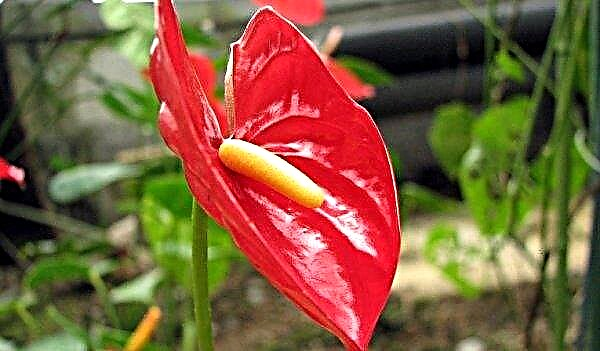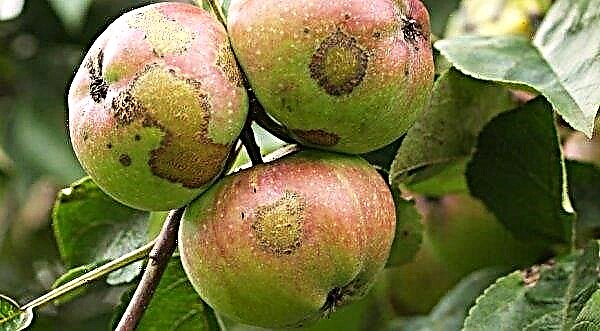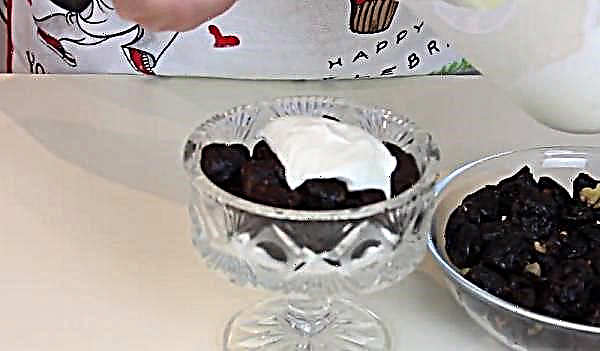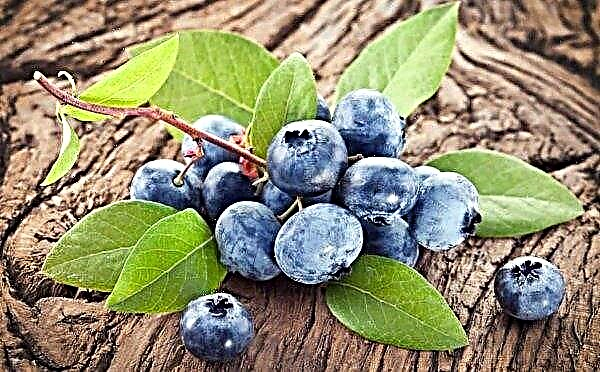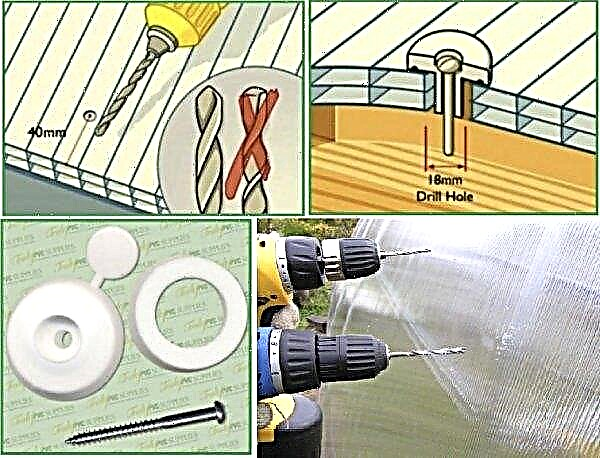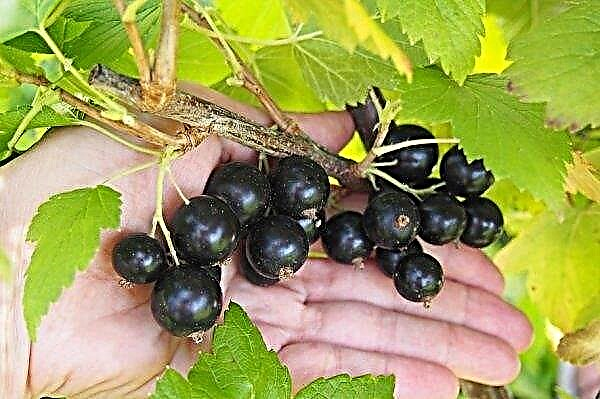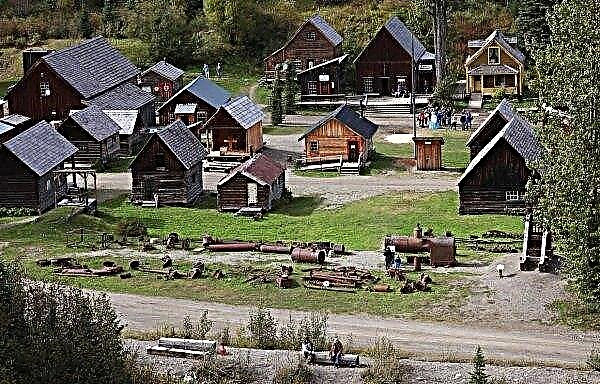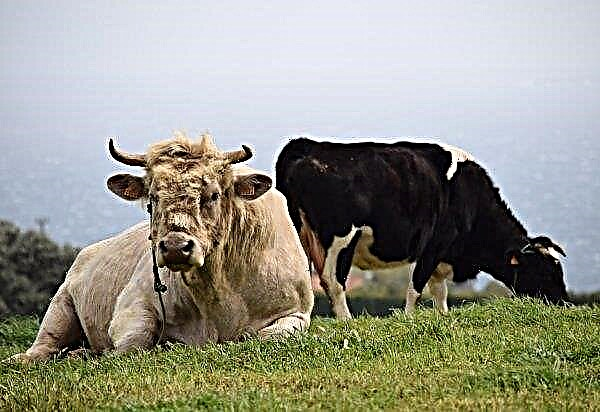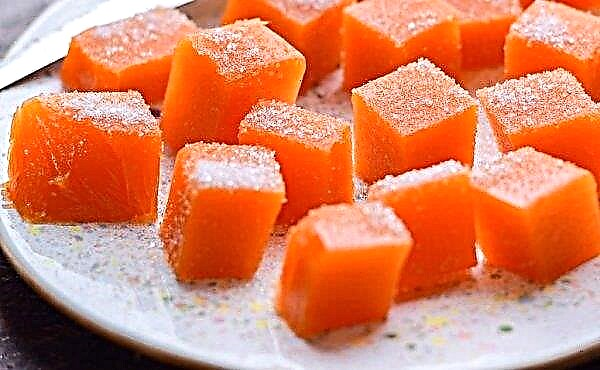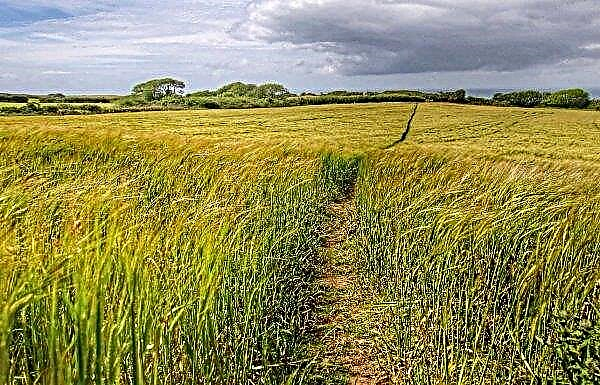Properly selected plants can decorate both large and small gardens. Compact size, attractive conical shape and impressive purple young buds are the hallmarks of Korean fir. You will learn about the proper agricultural techniques for growing this coniferous plant, reproduction and care from the article.
Description of Korean Fir
Korean fir is considered one of the lowest and most attractive for growing. Belongs to the pine family and comes from South Korea, where at the beginning of the XX century. it was discovered by the missionary. It grows in mountain ranges at an altitude of 1000–1900 m. It forms a wide-conical, dense crown and grows to 6–13 m, with a crown diameter of 1–2 m, but grows very slowly - after 10 years it reaches a height of 2 m. Its skeletal branches and shoots are located around the trunk almost horizontally from the ground and are densely covered with hard, short, rounded, thick needles, the upper side of which is dark green and shiny, and the lower almost white or silver from the wax coating. Young, light green or green-yellow spring growth is also decorative. The needles keep on shoots for a long time (for 6 years) and do not fall.
Its skeletal branches and shoots are located around the trunk almost horizontally from the ground and are densely covered with hard, short, rounded, thick needles, the upper side of which is dark green and shiny, and the lower almost white or silver from the wax coating. Young, light green or green-yellow spring growth is also decorative. The needles keep on shoots for a long time (for 6 years) and do not fall.
In addition to beautiful needles and shoots, a clear and regular crown shape, the main decoration of the tree are seed cones. They appear on the plant after several years of cultivation (even on 1–1.5-meter samples) and are tied at the very end of the branches. Cones are rather thick, cylindrical and not very long, and until ripening have an unusual blue-violet color.
Did you know? Specialists counted the needles on Nordman fir, and it turned out that a small tree 120 cm high has 200 thousand needles, and a larger tree (170 cm) - 300 thousand.
After ripening, they turn brown and become covered with resinous clusters, after which they decay directly on the tree, releasing the seeds enclosed inside under the scales. Although Korean fir is beautiful even in its natural form, it has many unusual and attractive varieties for garden cultivation, among which you can find tall and dwarf varieties growing in the form of a tree or shrub, and growing up to 60-100 cm.
How to plant in the open ground
The requirements for growing Korean fir are quite high and conditions should be created close to the natural environment of growth.
Which place in the garden prefers
The tree does not withstand either shade or cold and wet areas with dense and heavy soils, on which fir does not tie cones, and also often gets sick and dies. It does not tolerate polluted city air and drought; it grows well near ponds that improve air humidity. She likes areas with not too hot, humid summers and snowy winters. Korean fir copes well with low temperatures, but it should not be planted in cold regions and in open places blown by winter winds.
In Russian conditions, the southern warm regions, the Middle Strip, Siberia, the Urals and the Far East are suitable for growing Korean fir. The plant needs a warm and protected from winds and drafts place, solar exposure (with the exception of varieties with yellow needles, which prefer slightly shaded areas). Young seedlings are allowed to be planted in partial shade, taking into account that an adult plant will be well lit by the sun. But young growth can be damaged by late spring frosts.
Video: Korean fir
Soil requirements
The soil at the place of cultivation should be loose and fertile (with the addition of humus), well-drained and moist, but without stagnation of water, with a slightly acid reaction (pH 6.5–7.5). The culture grows poorly on sandy and dry soil.
Landing technology
If you plan to plant Korean fir in the garden, buy small specimens (30–40 cm high). They are easier to transport, they are accepted and rooted faster and cheaper. Plants bought in containers can be planted throughout the year, with the exception of periods of drought and frost. Root lump seedlings are planted in early spring or autumn. Make sure that the ground has thawed before spring planting.
Important! Pure Korean fir species can be propagated by sowing seeds, however, in the case of varietal decorative forms, only grafting or grafting is used.
Fir trees planted in spring and summer often dry out and require careful watering. Therefore, if possible, it is better to postpone the planting time in early autumn. Before winter, plants are well and deeply rooted, which is facilitated by autumn humidity and lower temperatures. Fir propagation can be done in three ways - using seeds, cuttings and grafting. So it will turn out to independently grow planting material and increase the collection of conifers in the garden.
Seeds
The most patient gardeners can try the propagation of fir from seeds, but this is a laborious and lengthy process, and the resulting plants often do not repeat the characteristics of the mother tree (you can use only the seeds of the species itself, but not its varieties). Reproduction by seeds requires stratification (hypothermia) for two weeks, and in the spring before sowing, soaking in warm and clean spring water.
Planting material is collected in September-October, stored in a dry room with high humidity, which is difficult to ensure at home. Sowing of seeds occurs in May in plastic containers that can be stored in the basement. When sprouts appear, they are planted in the ground.
Cuttings
The most convenient period for the propagation of fir cuttings is August and September. At this time of year, the shoots are harder and elastic enough to be trimmed. Since tree branches are difficult to root, only annual shoots in the upper part of the crown 6–10 cm long are selected for cuttings. They are cut with a knife or chopped off, trying to preserve a fragment of older wood. If they are longer than 10 cm, then only the top is cut. The lower part before planting is cleaned of scales and needles, treated with a rooting agent and planted in moist soil. Store seedlings in warm and humid conditions. The roots develop at a temperature of + 18 ... + 22 ° C and appear after 8-10 weeks.
If they are longer than 10 cm, then only the top is cut. The lower part before planting is cleaned of scales and needles, treated with a rooting agent and planted in moist soil. Store seedlings in warm and humid conditions. The roots develop at a temperature of + 18 ... + 22 ° C and appear after 8-10 weeks.
On the stem
Korean fir can be grown as a standalone tree or planted on a stem in early spring - such plants are often called "chupa-chups." As a stock, ordinary spruce or fir is used. The stem species are located on the second tier among the garden plantings, they look organically and make room for new plants.
Planting standard plants and caring for a tree are no different from the agricultural technology of conventional crops. The only thing that needs to be done for the winter is to put it on the spacers so that the trunk does not break under the weight of the crown and snow crust. Sometimes a rootstock shoot appears on the stem, which is removed in a timely manner.
Video: conifers on the stem
How to care for fir
Caring for Korean fir does not require much effort. The culture is unpretentious and well adapted to any conditions. But a certain set of procedures still needs to be provided - this is watering, mulching, fertilizing, and the prevention of pests and diseases. Abandoned conifers often get sick, grow incorrectly and lose needles.
Proper watering
Fir rather moderate watering (preferably in the evenings), and the frequency and rate depend on atmospheric conditions. In dry periods, it is necessary to irrigate the plantings every few days with large amounts of water in order to wet the soil to a depth of 30 cm. Irregular and surface irrigation leads to the growth of the root system near the surface, rather than in depth, which subsequently affects drought tolerance.
Evergreens are watered for a long time - even in late autumn and winter, if there is no snow and frost, and in early spring, if there is no rain. Conifers are subject to physiological drought during this period and the risk of winter drying. Well-irrigated plants tolerate winter frosts more easily. Mulching with coniferous materials (bark, sawdust, cones) reduces the growth of weeds and prevents the loss of moisture from the earth, and when decomposed, it additionally ensures the correct level of soil acidity and its fertility.
Mulching with coniferous materials (bark, sawdust, cones) reduces the growth of weeds and prevents the loss of moisture from the earth, and when decomposed, it additionally ensures the correct level of soil acidity and its fertility.
Fertilizer and fertilizing
In order to preserve the intense color of needles and cones, to maintain growth rates and a healthy appearance, it is important to properly feed coniferous crops. They begin to fertilize fir early in the spring and finish in July. In the future, top dressing, especially nitrogen, reduce frost resistance in the cold period. There is a wide selection of multicomponent mineral fertilizers such as Azofoska, Polyfoska, Fructus IGLAK, and ready-made mixtures specially adapted to the needs of conifers. Feeding is carried out in 3-4 doses with an interval of 30 days.
Another method of top dressing is the application of slow release fertilizer. They are used once in the spring (10 g for young trees, 20 g for adult specimens). These compounds are applied in a thin layer on the surface of the soil or mulch, where they will gradually stand out and nourish the trees throughout the growing season. For better rooting, stimulation of growth and increase the immunity of plants, foliar dressings are used, by spraying needles with solutions of mineral preparations ("Stimovit", "Bona Forte"). In addition to mineral fertilizers, it is necessary to use organic substances, enriching the earth in stem circles with humus and humic components to maintain fertility, because even the best mineral compounds will not help without it. To this end, compost is added to the soil under conifers at least every two years.
In addition to mineral fertilizers, it is necessary to use organic substances, enriching the earth in stem circles with humus and humic components to maintain fertility, because even the best mineral compounds will not help without it. To this end, compost is added to the soil under conifers at least every two years.
Video: how and when to fertilize conifers
Pruning
Due to its slow growth and compact form, the plant does not require pruning. For aesthetic reasons, only the lower branches can be removed if necessary. Easy correction and sanitary pruning, which is carried out before the sap flow begins in early spring in cool weather, is to remove dried, broken and frost-damaged branches, wood with signs of disease and damage by insect pests.
Important! Slices of coniferous plants can not be covered with varnish, since the emitted resin is a natural antiseptic, but should not be touched with their hands.
For thinning, whole branches are removed, which gives more light in the crown, increases air circulation and reduces the risk of plant morbidity. It is better to begin thinning by removing dead or diseased wood.
Winter preparations
Despite its southern origin, Korean fir is resistant to frost, so it feels great in Russian gardens. In winter, it is able to tolerate a drop in temperature to –25 ... –30 ° C without shelter. Only protection from strong winds and swampy soil is required, which, when frozen, will not allow the roots to feed the evergreen needles with moisture. In snowy winters, it is recommended to remove and shake off excess snow from the branches in order to avoid damage to the branches and deformation of the trunk. It is especially important to shelter young plants for the first 3-4 years in cold and snowless winters. Saplings for the winter can be insulated with agrofibre or other covering material. If the size of the plant allows, then to protect them from frost, they are covered with wooden crates and spruce branches are thrown on top. Such protection not only protects from the cold, but also saves the seedling from breaking under the weight of the snow infusion. To protect the root system, which can also suffer from severe frosts when freezing the ground at the base of the tree, use the procedure of mulching with a layer of 10-15 cm of trunk circles.
Saplings for the winter can be insulated with agrofibre or other covering material. If the size of the plant allows, then to protect them from frost, they are covered with wooden crates and spruce branches are thrown on top. Such protection not only protects from the cold, but also saves the seedling from breaking under the weight of the snow infusion. To protect the root system, which can also suffer from severe frosts when freezing the ground at the base of the tree, use the procedure of mulching with a layer of 10-15 cm of trunk circles.
Video: how to prepare conifers for winter
Prevention of diseases and pest attacks
Coniferous crops, due to their versatility, are found at every step today, but resistance to diseases or pests is not their strong point. More often they suffer under adverse weather conditions, violation of agricultural engineering rules and infection from neighboring plantations, and weakened trees become susceptible to damage. In general, Korean fir is resistant to diseases that occur mainly due to the dryness of the plant.
The most dangerous fungal diseases can be root rot, gray mold, fir rust, shute, bacteriosis. Among the pests, aphids, spruce-fir hermes, fir moths, spider mites and scale insects feeding on plant juices are especially dangerous. This leads to wilting, yellowing and falling of the needles. For the fight should use special chemicals designed for such lesions.
Preventive measures:
- To strengthen trees and increase their immunity, timely mulching, watering and top dressing with ammonium nitrate, ammonium sulfate or fertilizer for conifers are needed.
- Planting healthy material without signs of disease or pest damage.
- Ensuring light and air permeability due to sparse plantings, eliminating crown thickening and weed control.
- Do not cut fir with damp needles.
- In case of symptoms of diseases or the appearance of pests, the affected parts of the plant should be removed, and the entire plant should be sprayed with chemicals of the appropriate purpose. If the plant dies from soil infection, then the soil should be decontaminated before planting another seedling.

Korean Fir Mowing
If you are satisfied with the natural form of fir, then you can not do the crown correction. But many gardeners cut their hair to limit the size of the tree and give it an attractive configuration (wide or narrow). Mowing is carried out when the tree reaches a height of 1–2 m. At the same time, the tips of young shoots are trimmed, which are extended and extruded from the common conical shape.
This improves branching, and the removal of the tip of the center conductor limits growth. As a result, fir is formed into a dense and compact tree. Thick branches of old wood should not be shortened, because it weakens and disfigures plants, destroying their appearance.
Fir tolerates pruning well, but since it is a slowly growing tree, then the creation of fashionable and bizarre forms based on topiary (tiers, balls, domes) is not applied. An exception may be dwarf varieties and plants on the stem, allowing you to create some geometric shapes. The cutting procedure is done with cutting scissors, sharpened and sanitized. Disinfection of the cutting tool reduces the risk of transmission of the disease to other plants.
What can be planted nearby
Due to its beautiful shape, decorative needles and original cones, Korean spruce should be planted as a single tree in free space against a lawn, a bright wall of a building or a fence. It looks good in compositions with other, lower and dark conifers. As accompanying plants, it is worth choosing low herbs with a contrasting color and bright flowers. Due to its small growth, this plant is ideal for creating Japanese-style gardens. Near the fir you can plant flowers and shrubs (ornamental or berry).
Did you know? Fir is often used as a Christmas tree, because its needles are more firmly held on branches, do not fall even in heated rooms and are not as prickly as spruce.
In this case, you should choose plants that can tolerate shading, moderate humidity and acid soil:
- deciduous shrubs - barberry, dogwood;
- coniferous - juniper, thuja, yew, dwarf varieties of spruce;
- herbs and flowers - heather, azaleas, rhododendrons, hydrangeas, magnolias, calcium, euphorbia.
 The choice depends on the gardener's preferences. You can create beautiful multi-story compositions, the colors of which will vary according to the season, choosing species depending on the flowering period, color and height of the plants. There are many varieties of Korean fir on the market of garden plants, which differ in growth rate, crown shape and color of needles. It is worth enriching your own collection with one of these original trees, and all the care efforts will be rewarded with the beauty of an exotic tree.
The choice depends on the gardener's preferences. You can create beautiful multi-story compositions, the colors of which will vary according to the season, choosing species depending on the flowering period, color and height of the plants. There are many varieties of Korean fir on the market of garden plants, which differ in growth rate, crown shape and color of needles. It is worth enriching your own collection with one of these original trees, and all the care efforts will be rewarded with the beauty of an exotic tree.

